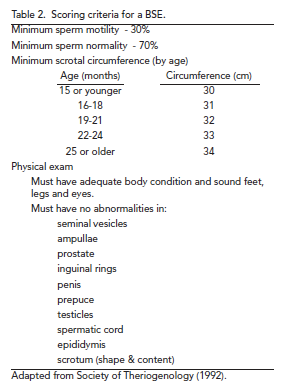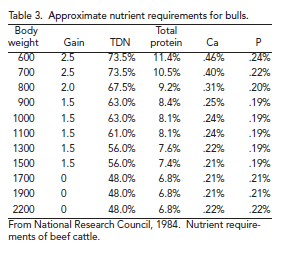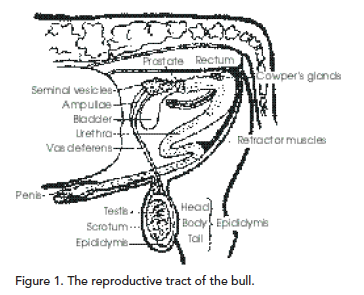L.R. Sprott, T.A. Thrift and B.B. Carpenter
Download the PDF | Email for Questions
Reproductive System | Breeding Soundness Evaluation | Libido and Ability to Mate | Nutrition | Genetic Factors Affecting Fertility
The importance of the bull in a cattle breeding program often is underestimated. A cow is responsible for half the genetic material in only one calf each year, while the bull is responsible for half the genetic material in 20 to 50 calves. The bull’s ability to locate cows in estrus and breed them is clearly vital to a successful breeding program.
Bulls differ in physical appearance, fertility and sex drive (libido). In the past, when a cow failed to become pregnant it was assumed that she was at fault. Occasionally, that is true. However, a clear understanding of the male reproductive system and the differences between reproductive capabilities of bulls indicates that the cow is not always at fault.
Reproductive System
One of the major organs of the bull’s reproductive system, the testis (or testicle), is made up of two tissues that perform different functions. The seminiferous tubules produce sperm, while the Leydig cells (interstitial tissue) produce tes-tosterone. The testes should be free and not adhering to the inside of the scrotum. A minor twist in the scrotum resulting in a slightly sideways suspension of the testicles may not affect reproductive performance but is abnormal in conformation and visually unpleasing. A major twist may indicate structural defect and reduced fertility.
The scrotum supports and encloses the testes. Its main function is to regulate testicular temperature. It does so through perspiration and by muscular contraction that raises the testicles in cold weather and relaxation that lowers them during warm weather.
Inside the scrotum (Fig. 1) and adjacent to each testicle is the epididymis, a 10- to 12-foot long, tightly coiled tube made up of three sections (head, body and tail). The functions of the epididymis are concentration (from 100 million/ cc to 4 billion/cc), storage, maturation and transportation of sperm cells. Immature sperm cells are immobile when they enter the epididymis, but become mobile after maturation. Their ability to fertilize an egg requires a period of retention in the female reproductive tract after mating, and exposure to certain compounds contained there.
The vas deferens extend from the epididymis to the ampullae. They aid in transport of sperm cells. Prior to ejaculation, sperm cells are pooled in the ampullae. The seminal vesicles and prostate gland contribute volume to the ejaculate by secreting fluid that contains substrates, buffers, inorganic ions (sodium, chlorine, calcium, etc.) and proteins. These proteins (known as fertility associated antigens) are particularly important since they bind to certain compounds in the female tract that increase the chances of fertilization. At ejaculation, the semen is transported via the urethra and through the penis.
Breeding Soundness
Bulls should be evaluated for breeding soundness 30 to 60 days before the start of breeding to allow sufficient time to replace questionable bulls. Bulls should also be evaluated at the end of breeding to determine if their fertility decreased. This second evaluation may explain a low calf crop percentage.
A breeding soundness evaluation (BSE) is administered by a veterinarian and includes a physical examination (feet, legs, eyes, teeth, flesh cover, scrotal size and shape), an internal and external examination of the reproductive tract, and semen evaluation for sperm cell motility and normality. Libido is not included in a BSE; it must be measured through visual observation during mating activity.
Physical Examination
Part of the physical examination involves the overall appearance of the bull. Flesh cover (body condition) is one factor to evaluate. Body condition can vary by breed, length of the breeding season, grazing and supplemental feeding conditions, number of cows the bull is expected to service, and distance required to travel during breeding. A thin bull may not have the stamina needed to service many cows in a short period on extensive range conditions (large acreage). An overly fat bull may lack vigor and not be able to breed up to his potential. Excessively thin bulls and fat bulls usually have low quality sperm. Ideally, bulls should have enough fat cover at the start of breeding so their ribs appear smooth across the animal’s sides.
Sound feet and legs are very important. Bulls with structural unsoundness such as sickle hocks, post legs, and bent or knock knees may develop soreness. The result is the inability to travel and mount for mating. Long hooves and corns between the hooves result in similar problems.
Eyes should be clear and injury free. The teeth are checked for excess wear or loss. The general health of the bull is critical since sick, aged and injured bulls are less likely to mate and usually have lower semen quality.
Examination of the Reproductive Tract
An internal (rectal exam) and external examination should be conducted. The rectal exam is to detect any abnormalities in the seminal vesicles, prostate, ampullae and the internal inguinal rings. Rarely are there any problems with the prostate, but an infection can occur in the seminal vesicles leading to a condition called seminal vesiculitis. This is not an unusual condition in bulls and is characterized by enlargement of the seminal vesicles. Rarely are there complications with the ampullae, but the inguinal rings are examined for indications of hernia. Major herniation can also be observed externally. The latter is characterized by abnormal enlargement of the scrotum and manual palpation of intestinal loops within the scrotum.
The external examination of the reproductive tract includes manual palpation of the testes, spermatic cords and epididymis. The testes should feel firm, while the upper portion of the epididymis should feel soft and free of any lumps or enlargements.
Degeneration of the testes may occur at any time and can be caused by prolonged hot weather with high humidity, poor blood circulation, age, trauma, stress, bacterial diseases of the testes and genetic susceptibility. A general sign of degeneration is a decrease in testicular size. Maintaining records of annual BSE results for each bull will help detect changes in testicular size.
Scrotal circumference is an important measure since it is directly related to the total mass of sperm producing tissue, sperm cell normality, and the onset of puberty in the bull and his female offspring. Bulls with large circumference will produce more sperm with higher normality. They also reach sexual maturity sooner, as do their daughters. Table 1 shows average scrotal circumference of various beef breeds.
Examination of the penis and prepuce will detect inflammation, prepucial adhesions, warts, abscesses and penile deviations. The erect penis should be parallel to the bull’s body.
Semen Evaluation
During a BSE, bulls will be electroejaculated and their semen should be microscopically evaluated for sperm cell motility and normality. Unless there is an obvious lack of sperm cells in the sample, cell concentration in the sample may not be very informative, as some bulls do not always respond well to electrical stimulus. Even then, it is wise to collect semen a second time to confirm if concentration is low. Sperm cell motility and normality are not necessarily affected by electroejaculation and can easily be assessed during examination. They are the most important characteristics because a high number of moving, normal sperm cells are required for fertilization of an egg.
The criteria for scoring on a BSE are shown in Table 2. Any bull meeting all minimum standards for the physical exam, scrotal size (varies by age and breed), and semen quality will be classed as a satisfactory potential breeder. Bulls that fail any minimum standard will be given a rating of “classification deferred.” This rating indicates that the bull will need another test to confirm status. Mature bulls should be retested after 6 weeks. Should they fail subsequent tests, mature bulls will be classed as unsatisfactory potential breeders.
Young bulls rated as classification deferred may not have reached sexual maturity and should be retested at monthly intervals until puberty is confirmed. It should be remembered that, even though accurate, a BSE is nothing more than a snapshot of a bull’s breeding potential at that point in time. Since a bull’s physical condition and sperm quality can change, a BSE should be done on all bulls annually prior to the start of breeding.
Libido and Ability to Mate
 Libido is, of course, a precursor to the ability to mate, but some bulls (10 to 35 percent) can not mate even though they have high libido. Injury, lameness, illness, and penile abnormalities may prevent bulls from accomplishing the act of mating. There is also evidence that libido and mating ability are genetically influenced.
Libido is, of course, a precursor to the ability to mate, but some bulls (10 to 35 percent) can not mate even though they have high libido. Injury, lameness, illness, and penile abnormalities may prevent bulls from accomplishing the act of mating. There is also evidence that libido and mating ability are genetically influenced.
Libido and the ability to mate are not measured during a BSE and can only be assessed by observing bulls in the presence of females. The number of mounts and services accomplished by the bull in a given period of time are recorded. Based on a scoring system, bulls are classed as having either high, moderate or low serving capacity. High serving capacity bulls are the most desirable because they settle more cows in fewer days than do moderate and low bulls. Whether formal tests for serving capacity are performed or not, producers are encouraged to observe their bulls during the breeding period to detect any bulls not performing their duties.
Unfortunately, libido and serving capacity are not related to BSE results or visual estimates of masculinity (thickness of the neck, muscle definition, coarseness of hair). Testosterone levels in the blood are slightly related, but only to a minimum threshold. Bulls with testosterone levels beyond this threshold are not necessarily good breeders.
Nutrition
Nutrition is important during the development of a young bull’s reproductive system. Improved levels of nutrition will hasten puberty and body development. Extremely high levels of nutrition may lower libido and magnify structural weakness.
Underfeeding for prolonged periods will delay puberty and cause irreversible testicular damage. If a mature bull is subjected to prolonged underfeeding, sperm quality and libido will decrease. Overfeeding of mature bulls may result in similar problems, but adjustments in feed levels may reverse the situation. Approximate nutrient requirements for growing and mature bulls are shown in Table 3.
Genetic Factors Affecting Fertility
The onset of puberty, libido and serving capacity are influenced by genetics. There are differences both between and within breeds. Recent work regarding the presence of fertility associated antigens in sperm (see “Reproduction System”) also indicates a degree of genetic control.
Generally, Bos taurus breeds mature at an earlier age than Bos indicus. Crossbreeds of these two will reach puberty at some age between their parent breeds. Other research indicates that earlier maturity in any breed can be accomplished by selection for increased yearling scrotal circumference.
In summary, many producers work hard to manage their cows for high fertility. They may assume that the bulls will do their expected duties, but thorough fertility management also includes attention to the bulls.


